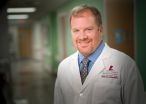For the last several years, researchers at the University of Illinois interested in improving screening programs for cancer have studied gene expression in mice, humans, and pigs in an effort to create a large-animal model that is more relevant to human cancers.
A new study from U of I researchers and other collaborators, recently published in PLOS One, reports the creation of such a model--a genetically engineered pig that allows researchers to induce the development of the same types of tumors seen in humans, reflecting the gene pathways and gene mutations most often observed in human cancer. Due to the genetic engineering, the tumors can be induced at any tissue site at any given time.
Lawrence Schook, a geneticist in the U of I Department of Animal Sciences, said that the "oncopig" model holds great promise not only in understanding and detecting cancer earlier, but also in developing new treatments and possible cures.
"We already knew which mutations cause cancer, but we wanted a model that would allow us to look for early detection of cancers," Schook said. "Currently, if a patient is diagnosed with stage 3 or 4 of certain types of cancer, it is often too late for drug, radiation, or surgical interventions. If we could induce tumors in various tissues at very specific times, we could come up with early diagnoses and screening tools. That will allow us, if you have early onset cancer, to do something early on in the progression of the cancer. That's been our goal."
Schook said the researchers are especially targeting cancers that are more difficult to diagnose in their early stages, including pancreatic, liver, lung, and bladder cancers. "These are devastating diseases for which early detection is critical. If we could detect them earlier, we have ways to treat them," he said.
During a decade-long collaboration with Professor Christopher Counter at Duke University, Schook said researchers identified the pig as a better model than mice because of the pig's similarities in anatomy, size, metabolism, and genetics to humans. And although the mice in their previous studies did develop tumors, the tumors were not similar to the tumors clinically observed in humans. And treatments, such as radiation or surgery, are simply not scalable to mice.
"Many people who are diagnosed with liver, pancreatic, or lung cancer, for example, have either been smokers or drinkers, or are overweight, or have cardiovascular disease. These are comorbidities. With the pig model, we can induce comorbidities in pigs. We can induce tumors in tissue that would be very similar to clinical human tumors," Schook said.
In the researchers' first paper, they described isolating fibroblasts from pigs, inserting the genes with the mutations into these cells, and testing for tumor formation in the donor pig's ear. "We know that those mutations cause tumors in humans, so we asked if we would see that in pigs and the answer was yes. It was the same pathway, the same genes, and the same mutation," he said.
Schook explained that because mutations in the genes (KRAS or TP53) are seen in nearly 50 percent of all human cancer, they targeted those genes in the pig model. The researchers engineered a construct of the pig genes with the added mutations. Because this construct is not expressed in normal cells, they "activated" expression of the mutated genes with an injection of a Cre recombinase enzyme, which induces tumors by signaling the gene to recombine.
"The pigs that are born with this gene inserted in them are normal animals, and if we expose a particular cell to this Cre enzyme, it gets activated and becomes tumorigenic. We can have control over the cell, as well as the location and the timing of inducing this signal," Schook explained. "We can target individual cells or tissues."
Depending on the location of injection, Schook said different types of tumors developed in the model. "It was what we expected. It was a proof of concept," he noted.
Because of the ability to target individual locations, the model is applicable to a range of types of cancers. "It also allows us to develop approaches to treating different cancers, depending on where they are located in the body," Schook explained. "We can begin to look at location and interventional radiology and microsurgery."
Along with strong the collaboration with Counter at Duke University, Schook said the University of Missouri's National Swine Resource and Research Center (NSRRC), supported by the National Institutes of Health (NIH), contributed to the project.
"We're excited that this pig is a national and international model that will be available to anybody doing research. They can get the model through the NSRRC," he said.
Schook and Laurie Rund, a research assistant professor in animal sciences, have also collaborated for several years with Champaign-Urbana-based Acoustic MedSystems, a medical device research and development company, in evaluating new image-guided minimally invasive ablative surgical methods.
"Currently, all the minimal invasive devices in the clinic or currently under investigation have never been tested in human-scale large-animal tumor models. All device testing has used normal tissues," Schook said. "This model essentially offers the opportunity to evaluate new therapies and devices in a human-size animal model."
Because of the "oncopig" model, Acoustic MedSystems (AMS) has developed several image-guided minimally invasive devices for treatment of tumors in several sites, including liver, kidney, spine, prostate, and brain. Recently, U of I and AMS piloted the use of the oncogenic pig model for evaluating a new high-intensity ultrasound therapy system for soft tissue tumors, culminating in the submission of a research proposal to the National Cancer Institute that proposes to induce tumor growth in genetically engineered oncogenic pigs and assess the treatment efficacy of 3D spatially registered image-guided catheter-based ultrasound thermal surgery. The project will be a collaborative partnership grant between AMS and U of I, with principal investigators Schook, Rund, and Everette C. Burdette of AMS.
"Success of the proposed work using the new tumor model in a large animal that is comparable in both scale and physiology to human patients will be beneficial to validate many minimally invasive modalities in addition to ultrasound therapy, but also other energy-based modalities including cryo-ablation, radiofrequency and microwave thermal therapy," the researchers reported in the proposal. "The validation test results from the model will ensure greater safety and permit treatment response evaluation prior to first-in-human clinical studies."
INFORMATION:
"A genetic porcine model of cancer" was recently published in PLOS One. Co-authors include Lawrence B. Schook , Tiago V. Collares, Wenping Hu, Ying Liang, Fernanda M. Rodrigues, Laurie A. Rund, Kyle M. Schachtschneider, Fabiana K. Seixas, Kuldeep Singh, Kevin D. Wells, Eric M. Walters, Randall S. Prather, and Christopher M. Counter.


